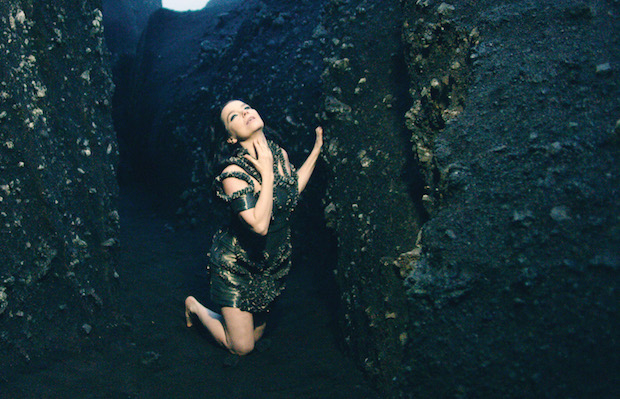Was intimacy the goal of Björk at MoMA? Co-curated by the Icelandic musician herself and Klaus Biesenbach, MoMA chief curator at large, the exhibition allows for a closer look at the objects that go into her productions, from custom-made instruments to haute-couture costumes and personal notebooks. The centrepiece, however, is the new commission Black Lake. At a press conference on Tuesday, Biesenbach made much of the live experience of museums in contrast to the detachment of seeing art through phones. The problem is, Björk’s exhibition isn’t live. It’s quite the opposite.
The culprit is the narrative installation called Songlines. An audio component entreats you to take it slow and to consider the device hanging around your neck as your heart. All very nice and cute. But it’s not necessary. One feels a sense of intimacy from Björk anyway; her music is personal, her delivery uninhibited.
Björk agreed to the exhibition on the condition it foregrounded music, which Biesenbach says it does in Songlines. Yes, sheet music lines the lobby. Yes, headphones deliver bursts of song. But it’s not enough. The exhibition doesn’t explore the how or why. How does Björk approach composition? What is her creative process? Her vocal and production styles aren’t contextualised, neither are the visual collaborations that have defined her image.
As you pass into each album-related exhibit, the music swoops in through your location-tracked device. Then it cuts out and you feel bereft, left reading a label about a costume on a dummy. Even more jarring, the music is spliced with a spoken fairytale based on Björk’s biography. It’s the opposite of ‘immersive’.
The videos are different. These reveal Björk as a performance artist. Collaborations with filmmakers including Michel Gondry, Chris Cunningham, Spike Jonze and Nick Knight show off the passionate theatricality that made her an icon. Seeing these in large format with surround audio is the emotional ride you wanted from Songlines. One video from new album Vulnicura – her ninth – was filmed by Inez & Vinoodh. Chiming with the Nineties fetish revival, it references the club kid era through which Björk came up. A pulsing shape at her chest represents her beating heart. It looks like a vagina, suggested in the title Vulnicura. (‘Vulnus’ is the Latin for ‘wound’. It’s not subtle, but you get the point.)
Black Lake evolved into Vulnicura. Screened on two opposing walls inside a black box, Björk appears large and alive and vulnerable. Stumbling around in a volcanic cave, clad in warrior mini-dress (Iris Van Herpen), Björk sings of heartbreak. Though archetypal Björk (Icelandic landscapes, emotional drama, embodied feminism), those who know her work will find a new encounter here. Otherworldly yet oddly mature and normal, she tells a tale of abandonment that can be found the world over.
Björk already has a multi-dimensional, multi-platform presence that very effectively tells her story; she has credibility and influence. The MoMA show tries to formalise all this but instead merely cramps her Gesamtkunstwerk style.







Comments